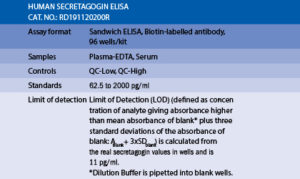Secretagogin Human ELISA
Secretagogin (SCGN, SEGN, CALBL, setagin) is a Ca-binding protein which consists of six-EF hand Ca-binding domains and is characterised by molecular weight of 32 kDa. Generally, Ca-binding proteins seem to be involved in several pathological conditions in the CNS, such as epilepsy or neurodegenerative disorders, for example Alzheimer´s disease. Secretagogin is expressed in central nervous system, particularly in the cerebellum, pituitary gland and hypotalamus, but also in thalamic tissue. Moreover, recent study shown, that secretagogin is detectable in human serum after ischemic brain damage. The secretagogin mRNA was identified as one of the most abundant transcripts in pancreatic islets, highlighting the potential importance of secretagogin in this tissue.
Secretagogin is down-regulated in pancreatic islets exposed to high concentration of glucose, in human non-functional pituitary adenomas and in adenocarcinomas. These results suggest that secretagogin may be involved in suppressing cell growth, and it has been proposed as a novel biomarker for diagnosis of different forms of cancer. Additionally, its strong expression in insulin secreting cells, its influence on insulin expression
might contribute to insulin homeostasis.
Areas of investigation: Neurodegenerative disease, Brain injury, Insulin secretion and Cancer.
The RD191120200R Human Secretagogin ELISA is a sandwich enzyme immunoassay for the quantitative measurement of human secretagogin (SCGN).
In the BioVendor Human Secretagogin ELISA, the standards, quality controls and samples are incubated in microtitrate wells pre-coated with polyclonal anti-human secretagogin antibody. After 60 min incubation and a washing, biotin labelled polyclonal anti-human secretagogin antibody is added and incubated with captured secretagogin for 60 min. After another washing, the streptavidin-HRP conjugate is added. After 30 min incubation and the last washing step, the remaining conjugate is allowed to react with the substrate solution (TMB). The reaction is stopped by addition of acidic solution, and absorbance of the resulting yellow product is measured. The absorbance is proportional to the concentration of secretagogin. A standard curve is constructed by plotting absorbance values against concentrations of standards, and concentrations of unknown samples are determined using this standard curve.
Intended use
Clinical Application
Test principle


Summary of protocol
– Zurek J, Fedora M. The usefulness of S100B, NSE, GFAP, NF-H, secretagogin and Hsp70 as a predictive biomarker of outcome in children with traumatic brain injury. Acta Neurochir (Wien). 2011 Oct 7;

